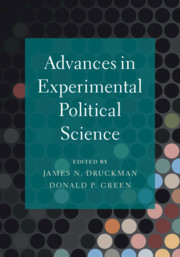Book contents
- Frontmatter
- Contents
- List of Figures
- List of Tables
- List of Boxes
- List of Contributors
- Acknowledgements
- 1 A New Era of Experimental Political Science
- Part I Experimental Designs
- Part II Experimental Data
- Part III Experimental Treatments and Measures
- Part IV Experimental Analys is and Presentation
- Part V Experimental Reliability and Generalizability
- Part VI Using Experiments to study Identity
- 23 Identity Experiments: Design Challenges and Opportunities for Studying Race and Ethnic Politics
- 24 The Evolution of Experiments on Racial Priming
- 25 The Evolution of Experiments on Gender in Elections
- 26 Gender Experiments in Comparative Politics
- Part VII Using Experiments to Study Government Actions
- Author Index
- Subject Index
24 - The Evolution of Experiments on Racial Priming
from Part VI - Using Experiments to study Identity
Published online by Cambridge University Press: 08 March 2021
- Frontmatter
- Contents
- List of Figures
- List of Tables
- List of Boxes
- List of Contributors
- Acknowledgements
- 1 A New Era of Experimental Political Science
- Part I Experimental Designs
- Part II Experimental Data
- Part III Experimental Treatments and Measures
- Part IV Experimental Analys is and Presentation
- Part V Experimental Reliability and Generalizability
- Part VI Using Experiments to study Identity
- 23 Identity Experiments: Design Challenges and Opportunities for Studying Race and Ethnic Politics
- 24 The Evolution of Experiments on Racial Priming
- 25 The Evolution of Experiments on Gender in Elections
- 26 Gender Experiments in Comparative Politics
- Part VII Using Experiments to Study Government Actions
- Author Index
- Subject Index
Summary
A large body of research shows exposure to racialized media and racist campaign communication can increase the likelihood that racial attitudes influence Americans’ subsequent political evaluations. Recent political trends, however, suggest existing models may no longer adequately explain the effects of racial and racist messages among whites and non-whites alike. Of particular importance for this question is whether implicitly racial messages still prime white Americans’ racial attitudes. Additional questions considered in this chapter include the following. Do classic theories of racial priming apply to political messages about other racial, ethnic, and religious minority groups? Who is most susceptible to racial priming? When should researchers measure racial attitudes in survey experiments? How can we design racial messages that are implicit? And do identity-based appeals and attacks commonly used today still prime ethno-racial identity attachments? We synthesize debates in the extant research on racial priming, explain why experiments are the best approach for measuring racial priming effects, discuss how to overcome several design and methodological challenges facing racial priming scholars, and then propose an agenda for future research to help address a variety of outstanding questions in this increasingly important area of scholarship.
Keywords
Information
- Type
- Chapter
- Information
- Advances in Experimental Political Science , pp. 447 - 467Publisher: Cambridge University PressPrint publication year: 2021
Accessibility standard: Unknown
Why this information is here
This section outlines the accessibility features of this content - including support for screen readers, full keyboard navigation and high-contrast display options. This may not be relevant for you.Accessibility Information
- 10
- Cited by
